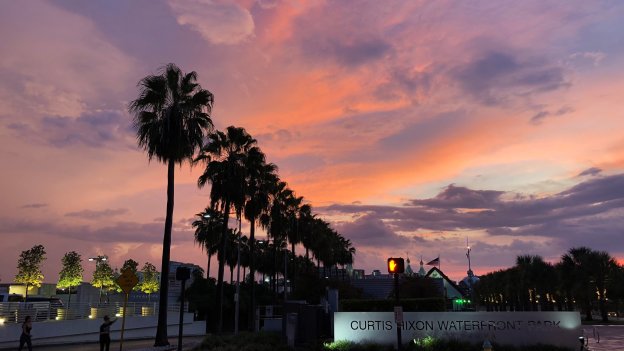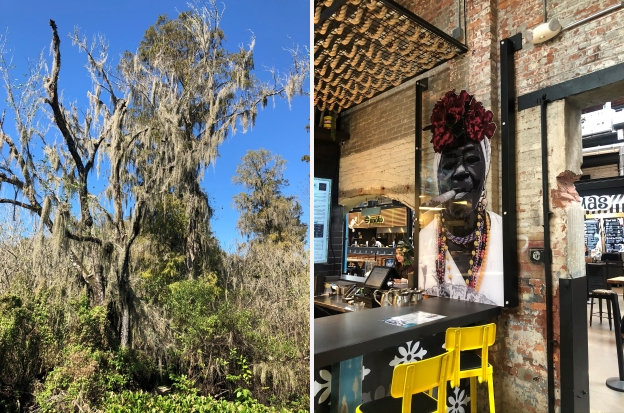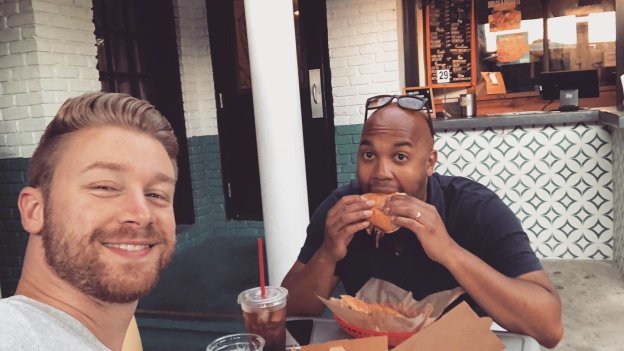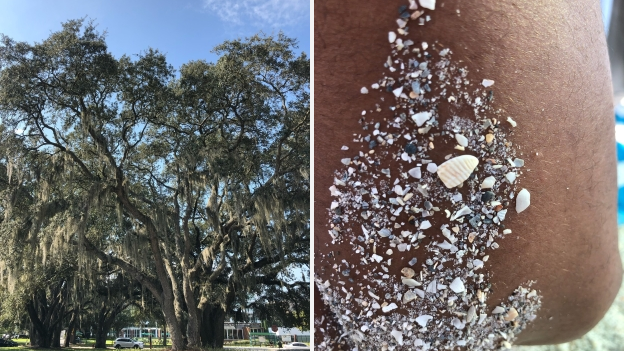Knox-Brown
 Privat
Privat
Patrick Knox-Brown captures the manifold sunset on the "Tampa Riverwalk"
"I still feel honoured to have received the scholarship from the DAAD-Stiftung in cooperation with the Prof. Dr. Bingel-Stiftung, which helped me to earn a key qualification and paved my way to a successful career."
Having gotten his master's degree in biotechnology at the FH Beuth Berlin, Patrick Knox-Brown worked as a postgraduate student as the university of Potsdam. As part of his dissertation and thanks to the Prof. Bingel Scholarship he was able to spend several months researching in the USA.
Here Patrick Knox-Brown shares how he experienced his time in the south of the country both academically and culturally:
Background information on the project and collaboration
Since plants are sessile organisms, they adapt to environmental influences (e.g. water deprivation) primarily at the molecular level. One mechanism, for instance, is the accumulation of late embryogenesis abundant (LEA) proteins. These proteins typically adapt from being intrinsically unstructured to having a distinct secondary structure in response to interaction with a binding partner or reduced availability of water. The acquired structure of the LEAs is usually an amphipathic-helix. In this state, they function as a molecular protectant of the cell, by protecting other proteins against aggregation or preventing damage to the cell membrane, thus contributing to the cell’s survival under abiotic stress.
To date, the best-researched LEA protein in the model organism Arabidopsis thaliana is cold-regulated protein 15A (COR15A), which is localised in chloroplasts. In previous studies, we were able to show that this protein protects vesicles with the specific chemical composition of chloroplast membranes against tearing and fusing in a freeze-thaw cycle.
In collaboration with Dr Gary Daughdrill at the University of South Florida (USF) in the USA, and thanks to his expertise in nuclear magnetic resonance (NMR), we were able to acquire high-resolution secondary structures from this protein. Together with other physical methods and mutants, we could show not only that the protective function of COR15A stems from the proportion of -helix (the more helical, the better), but also that the protein consists of three secondary structure building blocks – two helices connected by an unstructured linker. It was thus of great interest for the continuation of the project to examine other, previously generated mutants in which the linker or the two helices had been mutated in terms of their high-resolution secondary structure under various conditions and in view of water availability. This research is expected to augment and advance our understanding of the mechanism of the protective function.
Workplace and project implementation
After my arrival in Tampa, I moved into my new laboratory for the coming months with Dr Daughdrill. At the time, the working group consisted of three doctoral candidates and a master’s student. I was given my own office workstation, which is rather rare in Berlin-based working groups. Administratively, Dr Daughdrill had prepared everything thoroughly. I received a key card to access relevant labs. The laboratory itself was located in a building on the edge of the campus that housed mainly non-profit research groups.
In order to use my time as efficiently as possible, I had sent necessary materials for conducting my experiments to the lab in Tampa in advance by UPS. First, I conducted a test expression of my mutants in small bacterial culture batches in minimal media. This was followed by the expression of isotope-labelled proteins on a 2 L scale, initially of COR15A wild type and two mutants, in order to generate initial NMR data. Unfortunately, the USF Chemistry Institute had been restructured just prior to my arrival. As a result, every working group had a very limited time window available for conducting NMR measurements. However, I was able to use the waiting time constructively by learning the skills needed to evaluate and interpret NMR data.
I was able to reproduce the change in the secondary structure of COR15A and detect high-resolution secondary structures among those examined for one of the mutants. The data show that randomising the linker sequence does not induce any significant change in the overall structure or folding possibilities and, furthermore, that this results in unchanged protective function. However, permutation in the helix areas, which has no influence on the overall proportion of helix structure and protective function, showed differences to COR15A wild type even in a completely hydrated state. This is a highly interesting finding, which will be examined more closely in the future. I was not able to take all the measurements I had planned as part of my sponsorship by the DAAD-Stiftung. The collaboration with Dr Daughdrill’s laboratory will continue, however, so that the missing data for the remaining mutants can be collected.
Conclusion about the working group and project
I found the working atmosphere in Dr Daughdrill’s working group to be very pleasant and I was quickly integrated into the team. Some administrative and technical problems on location hampered the execution of the planned experiments. Nevertheless, I obtained exciting information about two COR15A mutations, which contribute to our detailed understanding of the folding behaviour and protective function. The data collected during the research period are to be summarised and published in two academic papers after completion.

Privat
Swamp landscape and mangrove covered in moss at "Lettuce Park" (left) and a glimpse inside the artfully designed street food market hall “Armature Works”(right)
Food, sights and travel
During my stay in Tampa, I had the opportunity to enjoy some leisure time. Even though Tampa is a relatively small city, it has a lot to offer. One place of interest, for example, is the Armature Works. This is an old brick industrial hall that was converted into a modern indoor street food market. Here you can enjoy anything from tacos, pizza and pasta to a steak or Asian fusion cuisine, as well as a fresh Barista coffee or a cocktail. In general, Tampa is home to a multitude of restaurants and bars. In the evenings, when the otherwise very hot weather had cooled down, we enjoyed walking along the nearly 4 km-long Tampa riverwalk. It runs along the Hillsborough River under palm trees and though downtown Tampa.

Privat
At the weekend, the centre of the action is Ybor City. It is a historic quarter founded around 1880 and was once a central hub of the cigar industry. The aquarium is also worth a visit. Here you can learn all about the diversity of species native to the Gulf of Mexico. At the weekend, they even offer boat tours for dolphin watching. The beaches outside the city also should not be missed. St. Petersburg is just under a 30-minute drive away from the city centre. It has the whitest beaches I have ever seen and you can swim in the Gulf of Mexico, which feels like a heated pool. In the other direction, just 10 minutes from the USF campus, was Lettuce Park. It is a swamp area with mangroves, moss and alligators. The natural scenery around Tampa is breath-taking. I will never forget the enormous moss-covered trees in my neighbourhood and on campus.
Acknowledgements
First and foremost, I would like to thank the DAAD-Stiftung in cooperation with the Prof. Dr. Bingel-Stiftung for approving my short-term scholarship application for doctoral candidates. The support not only intensified the transatlantic collaboration between the working groups of Dr Anja Thalhammer (University of Potsdam) and Dr Gary Daughdrill (University of South Florida), but also allowed me to conduct my chosen research project at the USF and enjoy a breath-taking visit to Tampa, Florida. I still feel honoured to have received the scholarship from the DAAD-Stiftung in cooperation with the Prof. Dr. Bingel-Stiftung, which helped me to earn a key qualification and paved my way to a successful career.

Privat
One of the enormous moss-covered trees described above on the USF campus (note the car for size reference; left) and the reason behind the white beaches (Madeira Beach) in St. Petersburg – crushed shells and coral (right)
I especially want to thank Ms Lohmann, as she was the best contact person I could have asked for before, during and after the sponsorship period. Her responses were always prompt, professional and extremely helpful. I also extend my sincere thanks to Dr Daughdrill for welcoming me to his laboratory and investing time to share his expertise. Finally, I am very grateful to my supervisor, Dr Thalhammer, for supporting me with planning the experiments and making me aware of the scholarship.
As of spring 2020. The German version is the original.


